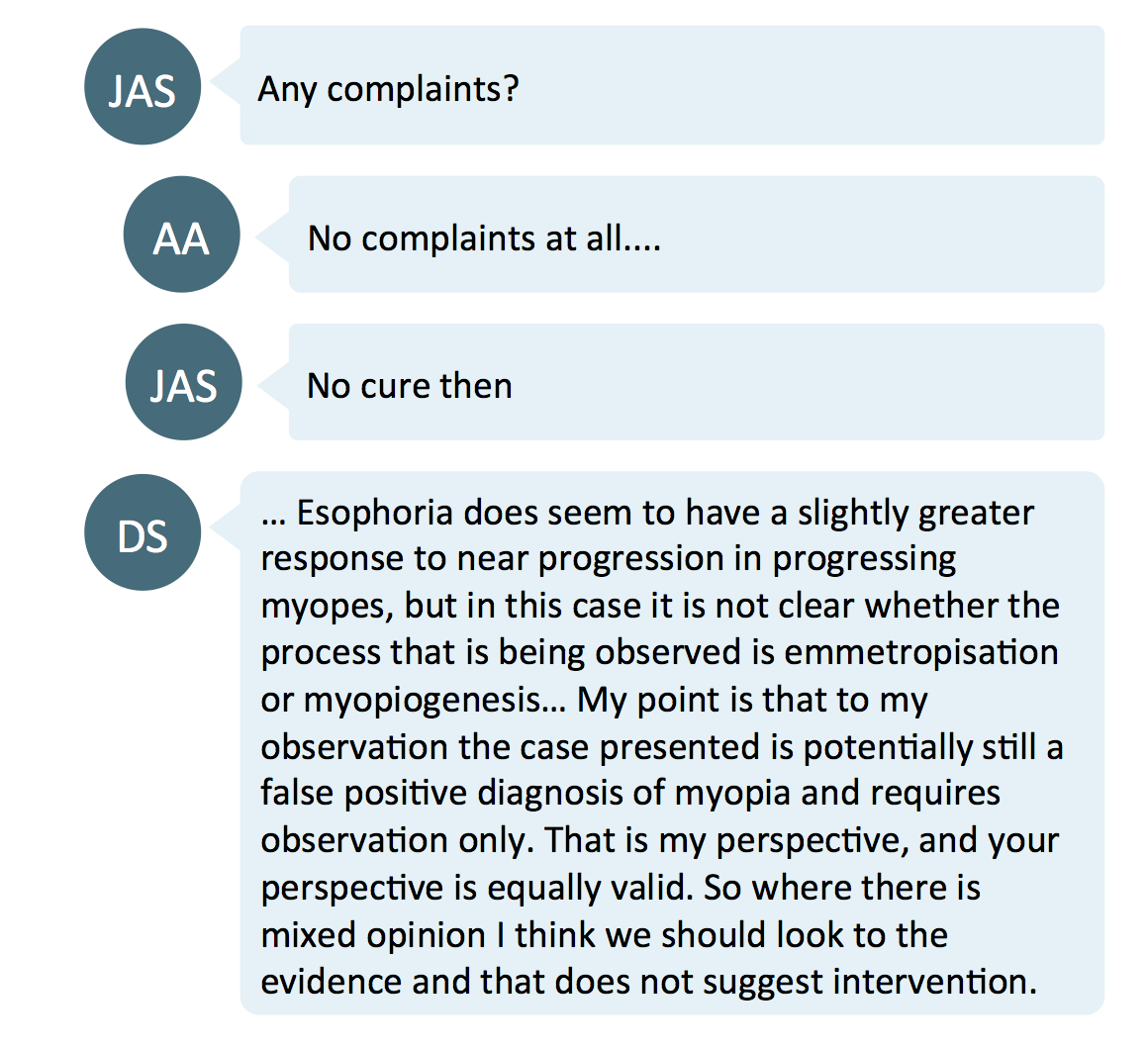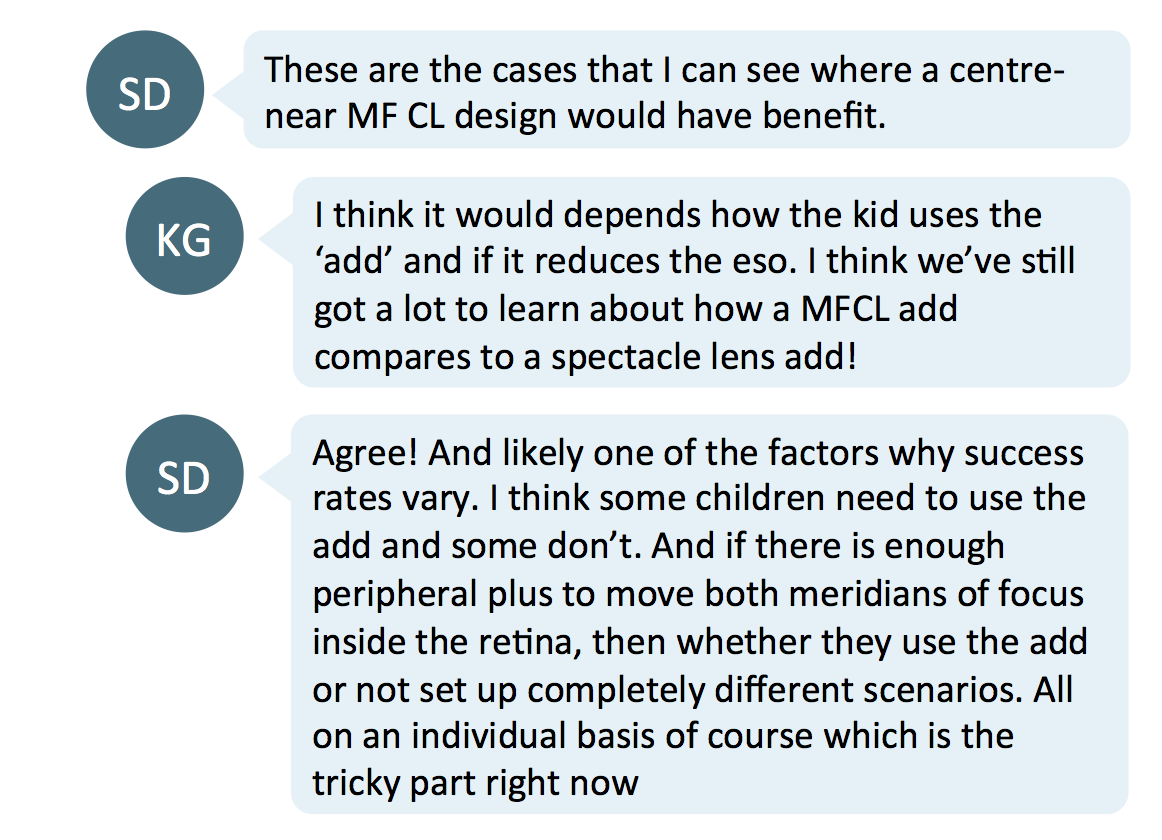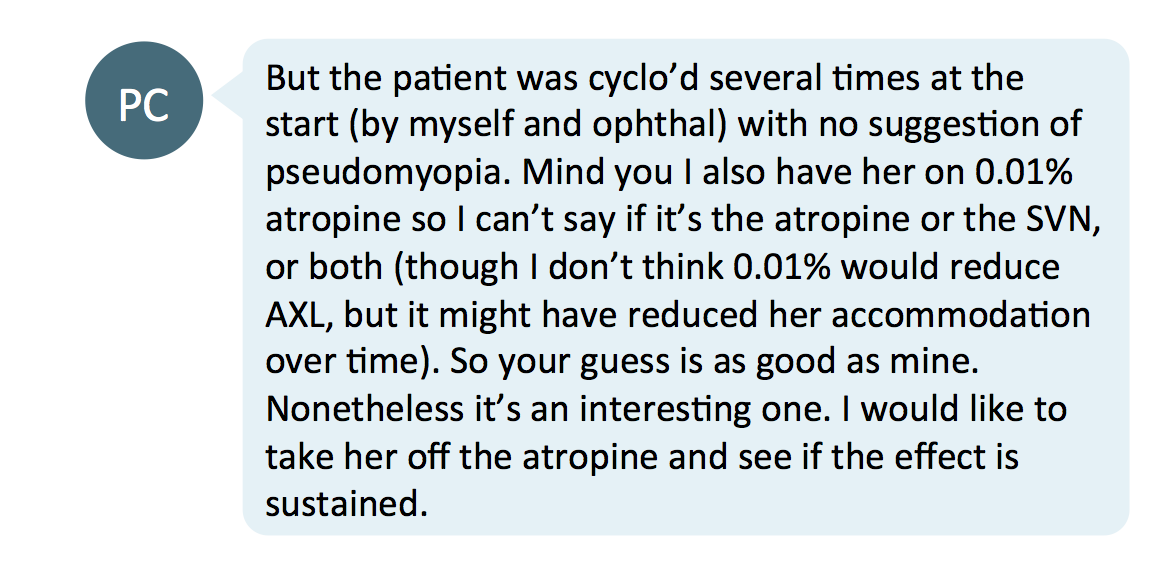In the post on the Myopia Profile Facebook discussion group, AA is looking for a recommendation treatment of a 8-year-old book lover who is highly esophoric without any visual complaint. Esophoria at near can be a risk factor for myopia development and progression - read more about this in How to identify and manage pre-myopes. Does it need to be managed in an emmetropic patient without symptoms? Is this child a pre-myope, and how should this factor into clinical management?

Is this patient a myope, pseudo-myope or pre-myope?

Before proceeding further, more tests such as a cycloplegic refraction and binocular vision workup need to be done to rule out pseudomyopia or overminussing. As the child reportedly loves to read, there could also be transient myopia due to prolonged near work.1
Cycloplegic refraction would allow you assess the true refractive power without the influence of a potentially compromised accommodative system. If this method is not available to you, careful refraction with accommodation in a relaxed state is important. SL’s experience of a pseudomyope patient with a high PRA (positive relative accommodation - ability to clear minus lenses binocularly) illustrates how abnormalities in binocular vision results can contribute to pseudomyopia.
According to International Myopia Institute (IMI) Defining and Classifying Myopia Report,2 myopia is defined as a condition in which the spherical equivalent refractive error of an eye is at least -0.50D when the ocular accommodation is relaxed. Therefore, this patient is not necessarily considered a myope yet as his refractive error is less than -0.50D. However, he clearly fits the definition of a pre-myope because he is:
- Less hyperopic than age-normal3
- Has myopia risk factors: myopic parents4 and esophoria,5,6 both of which have been linked to myopia onset and progression.
Read more about How to identify and manage pre-myopes via the link.
Is management necessary?


The commenters were split into two camps on this.
Some surmised that intervention at this stage was warranted due to the patient’s high esophoria. With a change in refractive error and esophoria associated with development of myopia,5,6 this group of people suggest that doing something to manage the esophoria is better than nothing if it will not cause harm, from the point of view of both pre-myopia management and the more immediate imperative of standard optometric / orthoptic management principles.
On the other hand, there were those who suggested that intervention was not necessary, due to the lack of symptoms and no evident myopia. As DS suggested, it is difficult to determine if this change in refractive error of R -0.25 and L -0.75 over a year is myopiogenesis or the normal emmetropisation process, especially as pseudo-myopia could be present - yet to be confirmed by cycloplegic refraction. This group of commenters suggested to monitor closely instead of intervening at this stage.
What are the options for those who decide to intervene?
If it is decided to intervene, the clinical decisions mainly surround how to manage the high esophoria. The options for this are as follows:
Glasses

- Single vision for reading: this is to neutralise the esophoria. This is usually not the first choice as the patient will experience blurry distance vision in the classroom and this may affect compliance. However, it’s an option to use for prolonged periods of near work when the parent is against a distance correction.
- Bifocal lens – the near addition can neutralise the esophoria. This is more convenient as it can be worn all the time and will help with compliance.
- Progressive lens – same function as the bifocal lens and its lack of a visible line can make this more appealing to those concerned with aesthetics.
Contact lenses

Centre-near multifocal soft contact lenses were suggested, presumed to be able to help with reducing accommodative responses and creating a shift to exophoria. Interestingly, there have been minimal comparisons in the literature on how centre-near and centre-distance soft multifocal contact lenses (MFCLs) comparatively influence binocular vision in young wearers. One study demonstrated that centre-near MFCLs created an accommodative lead where centre-near produced a lag, and near phoria was more exo in one centre-near MFCL.7
Other studies have since confirmed that centre-distance MFCL relax accommodation (increase lag) and create an exophoric shift, although this may vary by lens design.8-10
The most pertinent question in this case is if fitting contact lenses is justified if this child does not need vision correction - they would be fit instead to manage binocular vision and/or to potentially manage pre-myopia. Is this a valid approach? From the point of view of managing binocular vision, a spectacle lens will likely be more predictable. In terms of managing pre-myopia, this approach does not have direct research evidence, but could be logical - read more on this in our blog How to identify and manage pre-myopes.
Low Dose Atropine


PC added more to their earlier comment about an observied clinical case, where atropine had been a factor in reduction of apparent myopia or pseudo-myopia. Atropine can relax ciliary muscles and so could potentially have an effect on improving esophoria. In this case of pre-myopia, it could also serve as a myopia control treatment option. Wu et al11 showed that 0.025% atropine had an effect on reducing frequency of myopia onset in pre-myopes and the ATOM3 Clinical Trial underway is investigating 0.01% atropine to prevent and control myopia.
Take home messages:
- The esophoric and asymptomatic pre-myope can be tricky one to treat – do you wait and watch, or do you do something about the esophoria, knowing it could be linked to onset of myopia? Active management or observation are both clinically valid approaches - parents should be made aware of the risk factors the child has for myopia development, but also that management of the esophoria to reduce this risk is logical but not directly evidence based.
- Esophoria is known to be associated with the development and progression of myopia, but can also cause asthenopia and interfere with reading comfort in children. Hence treatment of significant binocular disorders as a principle of best practice optometric or orthoptic management is worth pursuit.12
- If the parents decline intervention with the binocular vision condition, evidence-based management of pre-myopia involves encouraging the child to increase their time spent outdoors to around two hours per day on average.13

About Kimberley
Kimberley Ngu is a clinical optometrist from Perth, Australia, with experience in patient education programs, having practiced in both Australia and Singapore.

About Connie
Connie Gan is a clinical optometrist from Kedah, Malaysia, who provides comprehensive vision care for children and runs the myopia management service in her clinical practice.
References:
- Ong E, Ciuffreda KJ. Nearwork-induced transient myopia. Documenta Ophthalmologica. 1995;91(1):57-85.(link)
- Flitcroft DI, He M, Jonas JB, Jong M, Naidoo K, Ohno-Matsui K, Rahi J, Resnikoff S, Vitale S, Yannuzzi L. IMI–Defining and classifying myopia: a proposed set of standards for clinical and epidemiologic studies. Investigative ophthalmology & visual science. 2019:28;60(3):M20-30. (link)
- Zadnik K, Sinnott LT, Cotter SA, Jones-Jordan LA, Kleinstein RN, Manny RE, Twelker JD, Mutti DO, Collaborative Longitudinal Evaluation of E, Refractive Error Study Group. Prediction of Juvenile-Onset Myopia . JAMA Ophthalmol. 2015;133:683-689. (link)
- Jones LA, Sinnott LT, Mutti DO, Mitchell GL, Moeschberger ML, Zadnik K. Parental History of Myopia, Sports and Outdoor Activities, and Future Myopia . Invest Ophthalmol Vis Sci. 2007;48:3524-3532. (link)
- Drobe B, de Saint-André R. The pre-myopic syndrome. Ophthalmic Physiol Opt. 1995; 15: 375–378. (link)
- Gwiazda J, Grice K, Held R, Thorn F, Bauer J. Insufficient accommodation and near esophoria: precursors or concomitants of juvenile-onset myopia?. InMyopia Updates 1998 (pp. 92-97). Springer, Tokyo. (link)
- Chung J, Bakaraju R, Fedtke C, Ozkan J, Ehrmann K, Falk D, Ho A, Holden B. Accommodative Lag, Facility and Phoria with Multifocal Contact Lenses. Invest. Ophthalmol. Vis. Sci. 2013;54(15):4251. (link)
- Gong CR, Troilo D, Richdale K. Accommodation and Phoria in Children Wearing Multifocal Contact Lenses. Optom Vis Sci. 2017;94(3):353-60. (link)
- Kang P, Wildsoet CF. Acute and short-term changes in visual function with multifocal soft contact lens wear in young adults. Cont Lens Anterior Eye. 2016;39(2):133-40. (link)
- Gifford KL, Schmid KL, Collins J, Maher C, Makan R, Nguyen TKP, et al. Accommodative responses of young adult myopes wearing multifocal contact lenses. Invest Ophthalmol Vis Sci. 2019;60(9):6376. (link)
- Fang, P. C., Chung, M. Y., Yu, H. J. & Wu, P. C. Prevention of myopia onset with 0.025% atropine in premyopic children . J Ocular Pharm Ther 26, 341-345, doi:10.1089/jop.2009.0135 (2010). (link)
- American Optometric Association. Care of the Patient with Accommodative and Vergence Dysfunction (St Louis, 2001). Accessed 19 October 2020. (link)
- Xiong, S. et al. Time spent in outdoor activities in relation to myopia prevention and control: a meta-analysis and systematic review . Acta Ophthalmologica 95, 551-566, doi:10.1111/aos.13403 (2017). (link)











